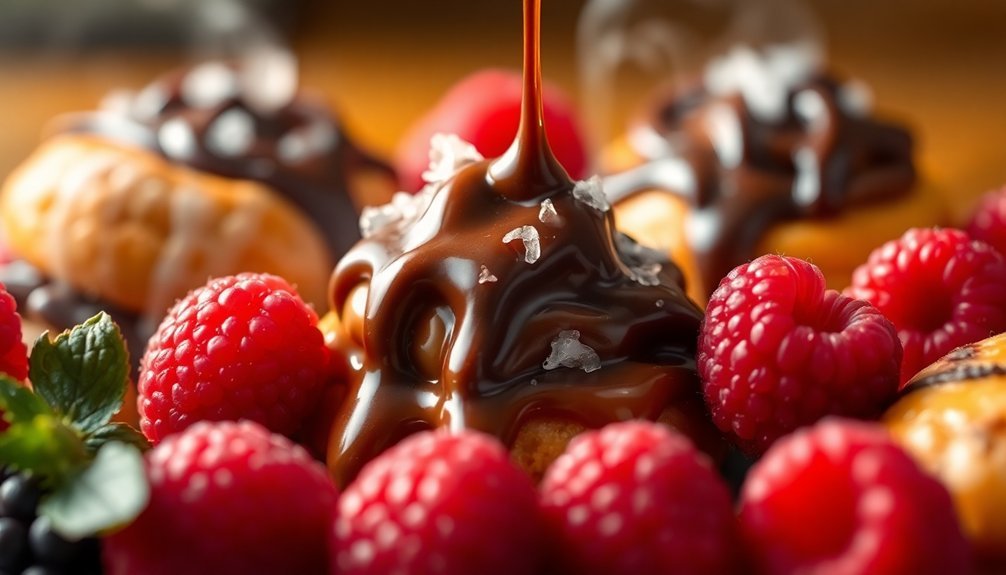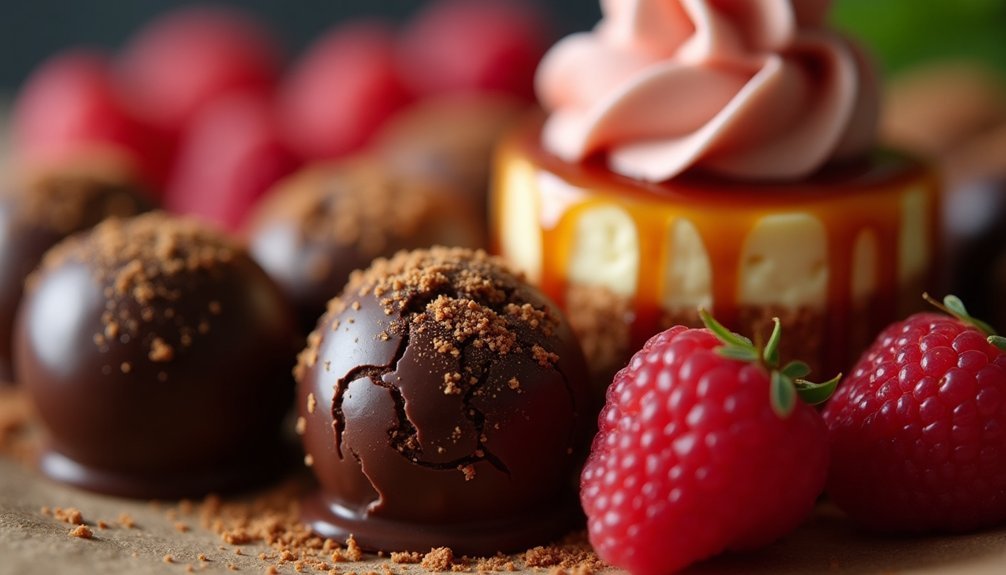Gourmand notes tap into your brain's primal connection between scent and emotion through the limbic system. When you encounter these food-inspired fragrances, they trigger powerful childhood memories of sweet treats, family gatherings, and comforting moments. Your nose actually detects 75% of what you perceive as taste, making these edible notes particularly seductive. The artful blend of sweet, spicy, and woody elements in modern gourmand perfumes offers a calorie-free journey into sensory pleasure and nostalgia.
The Primal Connection Between Food and Fragrance

When you smell a freshly baked apple pie, you're experiencing one of nature's most direct neural pathways. The aroma travels straight to your limbic system, triggering immediate emotional responses and memories before you're even conscious of them.
This primal connection explains why you can't resist certain food scents – they're hardwired into your brain's emotional center. These powerful aromas influence 75% of emotions when it comes to food-related experiences.
Your relationship with food-related scents begins before birth, as smell is your first fully developed sense. These early experiences shape your lifelong preferences and aversions.
When you eat, you're actually experiencing a complex interplay between taste and smell, with your nose doing most of the work. That's why pinching your nose while eating chocolate reduces its rich flavor to mere sweetness.
Your cultural background and personal experiences further shape how you interpret these gourmand scents.
Unlocking Childhood Memories Through Sweet Scents
The power of sweet scents to release childhood memories builds upon our primal connection to smell. Your brain processes scents through the olfactory bulb, creating direct pathways to emotional centers that store memories for years to come.
When you encounter gourmand fragrances like vanilla ice cream, freshly baked pastries, or caramel popcorn, you're transported back to specific childhood moments. These sweet aromas trigger vivid recollections of family gatherings, trips to the bakery, or summer afternoons at the fair. Studies show that marshmallow vanilla fragrances often remind people of their grandparents' bakeries and childhood treats.
It's not just about remembering – these scents can actually help reduce your stress and anxiety by reconnecting you with comforting childhood experiences.
You'll find that specific gourmand notes create an emotional cocoon, offering both nostalgia and indulgence while tapping into your deepest, most cherished memories of treats and celebrations.
The Art of Balancing Edible Notes in Perfumery

Creating balanced gourmand perfumes requires masterful manipulation of edible notes to achieve an intricate harmony between sweet and savory elements.
You'll find that perfumers use a drop-by-drop blending technique, carefully combining top, middle, and base notes in specific ratios like 3:2:1 or 4:2:1.
To create a well-rounded gourmand scent, you'll need to reflect on these essential balancing elements:
- Citrus and fruity notes to maintain freshness
- Spicy notes like cinnamon or star anise to cut through sweetness
- Woody or oriental elements to add depth and complexity
When you're experiencing a balanced gourmand perfume, you'll notice how the edible notes dance with floral, woody, or oriental accords. CO2 extraction methods are commonly used to capture the complex aromas of spices like pepper and nutmeg, adding depth to gourmand compositions.
It's this delicate interplay that prevents the fragrance from becoming overwhelmingly sweet while maintaining its indulgent, appetizing character.
From Dessert Table to Perfume Bottle: Evolution of Gourmand Scents
Looking beyond the art of balancing notes, you'll find that gourmand perfumery has a rich heritage spanning centuries. From ancient civilizations using fragrant spices to modern-day innovations, the evolution has been remarkable. While Guerlain's "Jicky" and "Shalimar" laid the groundwork, it wasn't until Thierry Mugler's "Angel" in 1992 that gourmand truly emerged as a distinct category.
| Era | Milestone | Impact |
|---|---|---|
| Ancient Times | Spices & Resins | Ritual & Emotion |
| Late 19th C. | Jicky (1889) | Vanilla Pioneer |
| 1990s | Angel (1992) | Category Definition |
Today's gourmand scents leverage technology to recreate complex culinary experiences, from steamed vegetables to roasted nuts. You'll find these fragrances dominating 60% of the market, driven by your desire for comfort and nostalgia in an increasingly fast-paced world.
Creating Emotional Bonds Through Culinary-Inspired Fragrances

When you experience a gourmand fragrance, your senses instantly connect to powerful emotional memories of childhood treats and comforting moments.
These culinary-inspired scents tap into your deepest memories, triggering feelings of warmth and nostalgia that can brighten your mood and reduce tension.
You'll find these fragrances particularly enchanting because they offer a sensory escape through their complex profiles, combining sweet notes with unexpected ingredients.
Modern perfumers continue to innovate, creating unique combinations that surprise and delight your senses.
Key aspects that make gourmand fragrances irresistible:
- They transport you to cherished moments through familiar dessert-like aromas
- They provide an indulgent experience without the calories
- They blend traditional sweet notes with innovative ingredients like steamed rice or salty accents
Frequently Asked Questions
Are Gourmand Fragrances More Likely to Cause Skin Allergies?
You're not at higher risk of skin allergies with gourmand fragrances specifically. It's the individual ingredients, not the fragrance family, that determine allergenicity. Your sensitivity depends on specific chemical components used.
Do Gourmand Perfumes Attract Insects More Than Other Fragrance Families?
Yes, you'll likely attract more insects with gourmand perfumes since they contain fruity and floral notes that mimic natural food sources. However, some gourmand ingredients, like coconut, might actually help repel certain insects.
Can Wearing Gourmand Scents Affect Appetite or Food Cravings?
Yes, your gourmand perfumes can increase your appetite and trigger food cravings. When you wear these food-like scents, they'll stimulate your olfactory system, leading to physical responses like salivation and heightened hunger sensations.
Which Skin Types Hold Gourmand Fragrances Longer?
If you have oily skin, you'll notice gourmand fragrances last longer on you. Your skin's natural oils act like a perfume primer, helping scent molecules bind better than they would on dry skin.
Are Gourmand Fragrances More Suitable for Certain Seasons or Climates?
You'll find gourmand fragrances work best in autumn and winter, when their sweet, rich notes complement the cold weather. They're less suitable for spring and summer, where they can become overwhelming in heat.
In Summary
You'll find that gourmand notes captivate you on a deeply personal level, tapping into your cherished food memories and primal instincts. When you experience these edible-inspired scents, they're not just pleasant aromas – they're emotional time machines that transport you back to comforting moments. Whether it's vanilla, chocolate, or caramel, these notes speak a universal language that you instinctively understand and crave.





Leave a Reply